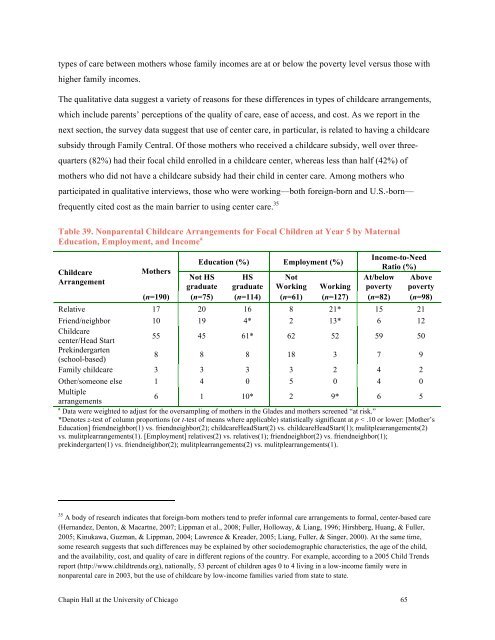2011 The Palm Beach County Family Study (Full Report)
2011 The Palm Beach County Family Study (Full Report)
2011 The Palm Beach County Family Study (Full Report)
- No tags were found...
Create successful ePaper yourself
Turn your PDF publications into a flip-book with our unique Google optimized e-Paper software.
types of care between mothers whose family incomes are at or below the poverty level versus those withhigher family incomes.<strong>The</strong> qualitative data suggest a variety of reasons for these differences in types of childcare arrangements,which include parents’ perceptions of the quality of care, ease of access, and cost. As we report in thenext section, the survey data suggest that use of center care, in particular, is related to having a childcaresubsidy through <strong>Family</strong> Central. Of those mothers who received a childcare subsidy, well over threequarters(82%) had their focal child enrolled in a childcare center, whereas less than half (42%) ofmothers who did not have a childcare subsidy had their child in center care. Among mothers whoparticipated in qualitative interviews, those who were working—both foreign-born and U.S.-born—frequently cited cost as the main barrier to using center care. 35Table 39. Nonparental Childcare Arrangements for Focal Children at Year 5 by MaternalEducation, Employment, and Income aChildcareArrangementMothersIncome-to-NeedEducation (%) Employment (%)Ratio (%)Not HS HS NotAt/below Abovegraduate graduate Working Working poverty poverty(n=190) (n=75) (n=114) (n=61) (n=127) (n=82) (n=98)Relative 17 20 16 8 21* 15 21Friend/neighbor 10 19 4* 2 13* 6 12Childcarecenter/Head Start55 45 61* 62 52 59 50Prekindergarten(school-based)8 8 8 18 3 7 9<strong>Family</strong> childcare 3 3 3 3 2 4 2Other/someone else 1 4 0 5 0 4 0Multiple6 1 10* 2 9* 6 5arrangementsa Data were weighted to adjust for the oversampling of mothers in the Glades and mothers screened “at risk.”*Denotes z-test of column proportions (or t-test of means where applicable) statistically significant at p < .10 or lower: [Mother’sEducation] friendneighbor(1) vs. friendneighbor(2); childcareHeadStart(2) vs. childcareHeadStart(1); mulitplearrangements(2)vs. mulitplearrangements(1). [Employment] relatives(2) vs. relatives(1); friendneighbor(2) vs. friendneighbor(1);prekindergarten(1) vs. friendneighbor(2); mulitplearrangements(2) vs. mulitplearrangements(1).35 A body of research indicates that foreign-born mothers tend to prefer informal care arrangements to formal, center-based care(Hernandez, Denton, & Macartne, 2007; Lippman et al., 2008; <strong>Full</strong>er, Holloway, & Liang, 1996; Hirshberg, Huang, & <strong>Full</strong>er,2005; Kinukawa, Guzman, & Lippman, 2004; Lawrence & Kreader, 2005; Liang, <strong>Full</strong>er, & Singer, 2000). At the same time,some research suggests that such differences may be explained by other sociodemographic characteristics, the age of the child,and the availability, cost, and quality of care in different regions of the country. For example, according to a 2005 Child Trendsreport (http://www.childtrends.org), nationally, 53 percent of children ages 0 to 4 living in a low-income family were innonparental care in 2003, but the use of childcare by low-income families varied from state to state.Chapin Hall at the University of Chicago 65
















